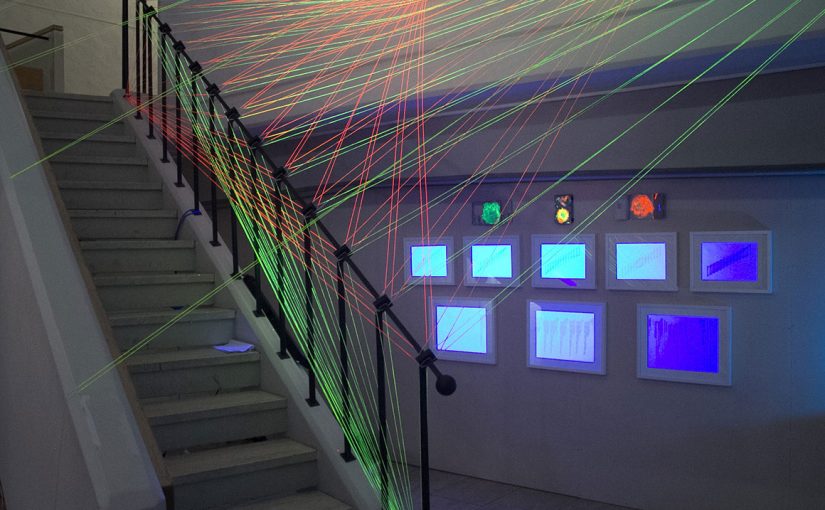Static Sculptural Installation
Exploring themes of sacred geometry, gamification and the opaque nature of game technology, this installation projects a virtual shape onto a functioning staircase.
‘Level Up!’ began as an attempt to highlight geometric principals of repetition and symmetry within basic architecture. By winding string through each of the spokes of the bannister, a relationship could be drawn out between them in a tangibly physical manner.
After this initial exploration (the bottom most point of the bannister being connected to each of the points along the top), I decided that it would be too time consuming to experiment with all of the different patterned combinations of string. Instead, I decided that it would be more efficient to recreate the scene digitally so I could experiment with all the different ways of stringing up the bannister.
I wrote a program to visualise the bannister and then wrote a number of algorithms for drawing different patterns of varying complexity. I decided upon a fairly simple yet geometrically appealing design which gave the pattern depth and reminded me of perspective grids from the movie ‘Tron’ and other such ‘retro sci-fi’ aesthetics.
After completing this portion of the installation I decided to experiment with stringing together other parts of the staircase. Between the sections of the staircase (the main bannister, above the bannister, and overhanging the stairs) there are three levels of detail which are mirroring the effect of polygonal tessellation in videogame geometry. In computer graphics, tessellation is a process similar in concept to mip-mapping where more or less detailed versions of an object are served to the player’s graphics card according to their distance so as to optimise the ratio between graphical fidelity and hardware performance.
At the top of the staircase sits a bowl of candy, any staircase dweller/adventurer brave enough to endure the arduous journey of ‘The Dreaded Staircase’ is rewarded by being allowed to take some candy. This stands as a parody of the current infatuation with and misunderstood nature of ‘gamification’ as a subset of Serious Games.
Next to the staircase I have printed some of the unused designs and framed them along with the actual code used to create them. This not only illuminates part of my process but highlights the opaque barrier to understanding of how videogames work. There is also an interesting interplay present between elements of the real world being recreated on a screen, and elements usually found on a screen being printed and displayed within a frame.
There is an element of vulnerability present in the public display of code.
Complimenting this comparison are the three paint palettes used when painting the string which I have mounted too. These are actually pieces of metal from abandoned computer components which have been flattened and used to mix the fluorescent paint.
